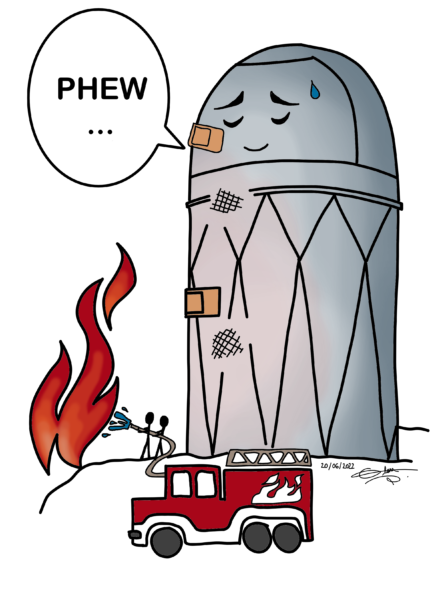Angela Berti, University of Utah
June 29, 2022
On Saturday, June 11 a lightning strike started a wildfire in the Arizona mountains less than ten miles from the Kitt Peak National Observatory (KPNO), where DESI observing is done with the Mayall 4-meter telescope. Besides the Mayall, Kitt Peak is home to over 20 telescopes and other buildings that support scientific observations on the mountain, including dormitories where staff sleep. All of these structures were potentially threatened by the wildfire.
By Tuesday, June 14 the wildfire (now called the Contreras Fire) had spread to thousands of acres and was less than five miles from Kitt Peak. Around noon local time KPNO safety staff and the fire Incident Commander told everyone on site to immediately prepare to evacuate the mountain. Observing would have to be put on hold. The night of June 13 would be DESI’s final look at the sky for at least several weeks. Within hours a convoy was organized and began to bring those at the summit down the mountain to safety. A skeleton crew of four remained at the summit overnight for full-time fire watch.
On Wednesday, June 15 about 15 firefighters were at KPNO clearing defensive space around observatory buildings. Eight NOIRLab staff were also allowed to return for a few hours to protect critical equipment. This included taping plastic sheets and tarps over DESI’s prime focus corrector and the Mayall telescope’s primary mirror. These sensitive components could be damaged by smoke and ash should the fire get too close.

Nearly 200 firefighters were by then battling the Contreras fire, which was now only three miles away to the south. By the evening at least seven large air tankers were dropping fire retardant near KPNO.
The fire was just two miles away by the morning of June 16. Firefighting teams dropped over 100 loads of fire retardant along the perimeter of the observatory, and local news reported that the Contreras fire was the “#1 priority to wildland fire in the entire United States” due to the value of KPNO.
By early morning on Friday, June 17, the fire swept over the Southwest Ridge section of the observatory, home to MDM Observatory (two optical telescopes), the Arizona Radio Observatory, and the NRAO Very Long Baseline Array radio dish. KPNO webcams mounted on some of the telescopes stopped returning images not long after as the fire disrupted electricity and internet service on the mountain. DESI collaborators around the world could no longer monitor instruments remotely due to the loss of connectivity.


Good news finally came around midday on June 17 as light rain began to fall in nearby Tucson, Arizona. In the afternoon word came from two employees of NOIRLab who were on the mountain assisting firefighters with KPNO’s water system that no fire had reached the Mayall telescope. By the time the Contreras fire was 100% contained it had spread to nearly 30,000 acres. The fire destroyed four “non-scientific” structures, but none of the more than 20 telescopes atop Kitt Peak were burned!
On Tuesday, June 21, the DESI collaboration gathered in Berkeley, California for its first in-person meeting since 2019 due to the covid-19 pandemic. Many collaboration members who couldn’t be there in person joined remotely, and everyone expressed their gratitude for the incredible firefighters who saved DESI and KPNO from the Contreras fire.
